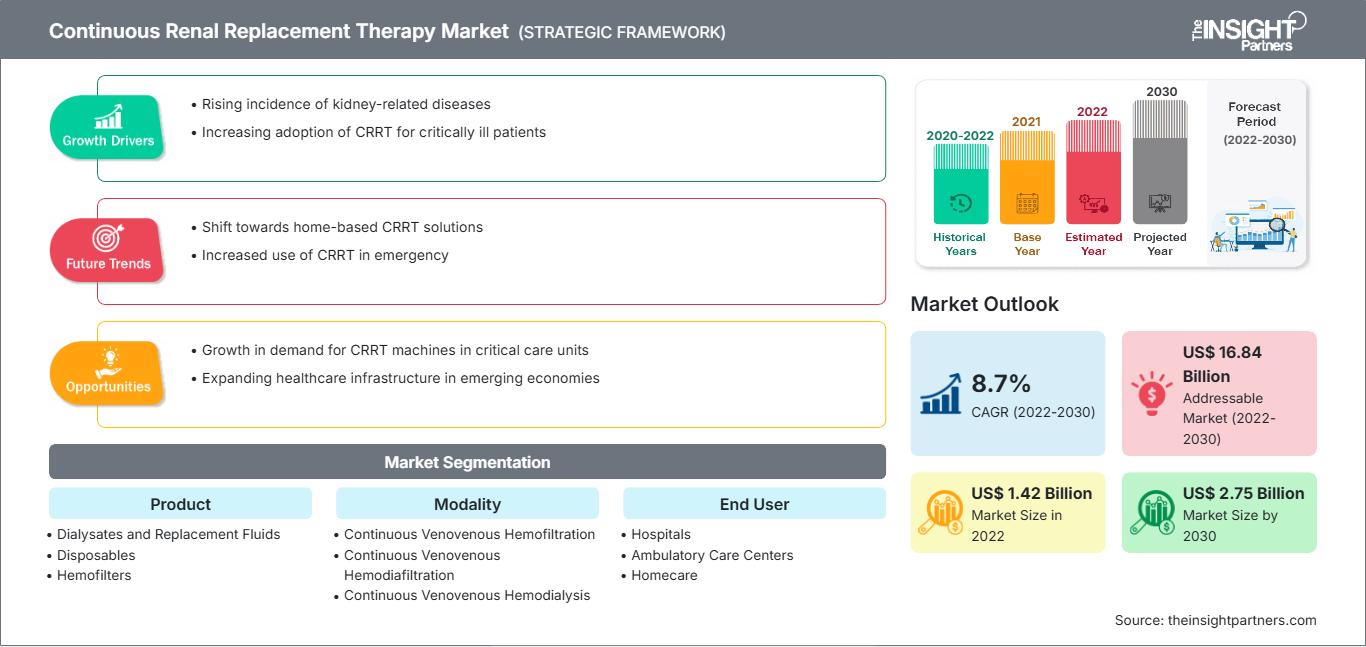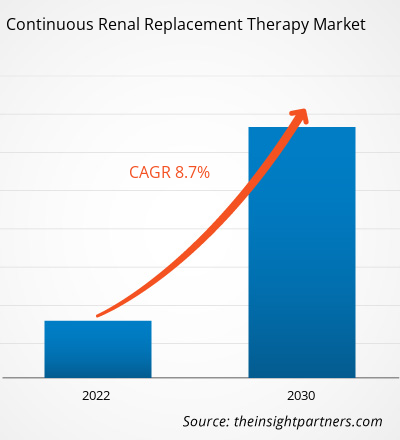[Forschungsbericht] Der Markt für kontinuierliche Nierenersatztherapie soll laut Prognosen von 1,42 Milliarden US-Dollar im Jahr 2022 auf 2,75 Milliarden US-Dollar im Jahr 2030 wachsen. Von 2022 bis 2030 wird eine durchschnittliche jährliche Wachstumsrate (CAGR) von 8,7 % erwartet.
Markteinblicke und Analystenmeinung:
Dieser Bericht enthält Wachstumsaussichten aufgrund der aktuellen Markttrends für kontinuierliche Nierenersatztherapie und ihrer vorhersehbaren Auswirkungen im Prognosezeitraum.
Die kontinuierliche Nierenersatztherapie (CRRT) ist ein lebensrettender Eingriff für Patienten mit schwerem akutem Nierenversagen (AKI), Flüssigkeitsüberladung und Urämie mit potenziell tödlichen Stoffwechselstörungen. Faktoren wie die gestiegene Nachfrage nach pädiatrischen CRRT-Geräten und die hohe Prävalenz chronischer Krankheiten, die zu Nierenerkrankungen führen, treiben das Wachstum des Marktes für kontinuierliche Nierenersatztherapie voran. Allerdings begrenzt ein erhebliches Risiko eines schwerwiegenden unerwünschten Nierenereignisses (MAKE) das Marktwachstum.
Markttreiber:
Hohe Inzidenz chronischer Krankheiten, die zu Nierenerkrankungen führen
Weltweit ist 1 von 10 Menschen von einer chronischen Nierenerkrankung (CKD) betroffen, einer häufigen und lebensbedrohlichen Erkrankung. Von 2015 bis 2019 waren Diabetes und Bluthochdruck in 75 % aller Nierenversagensfälle die beiden Hauptursachen. Schätzungen der National Kidney Foundation aus dem Jahr 2020 zufolge besteht in den USA für etwa 30 % der Diabetiker über 20 Jahren das Risiko, im Laufe ihres Lebens an einer CKD zu erkranken. Darüber hinaus forderte diese Krankheit im Jahr 2020 mehr Todesfälle als Prostatakrebs oder Brustkrebs und ist eine zu wenig erkannte gesundheitliche Notlage. 1 von 3 amerikanischen Erwachsenen (also etwa 80 Millionen Menschen) läuft Gefahr, eine chronische Nierenerkrankung zu erkranken, die mittlerweile als klarer Risikofaktor für ein akutes Nierenversagen (AKI) gilt. Eine verringerte glomeruläre Filtrationsrate (GFR) und eine erhöhte Proteinurie stehen in engem Zusammenhang mit einem akuten Nierenversagen (AKI).
Dem National Institute of Health zufolge nimmt die Zahl der Fälle von AKI in Industrieländern zu. Bei stationären Krankenhauspatienten wird mit einer Prävalenz von 15 % gerechnet, bei Schwerstkranken liegt sie sogar bei 60 %. Die AKI-Inzidenz bei stationären Patienten liegt weltweit zwischen 0,7 % und 31 %; auf Intensivstationen liegt sie bei über 50 %. Zwischen 3 % und 13 % der Patienten mit AKI benötigen eine Nierenersatztherapie, und 40 % dieser Patienten benötigen schätzungsweise mehr als 90 Tage lang eine chronische Nierenersatztherapie. Die hohe Prävalenz chronischer Erkrankungen, die zu Nierenerkrankungen führen, fördert das Marktwachstum der kontinuierlichen Nierenersatztherapie.
Zu den schwerwiegendsten Nebenwirkungen der kontinuierlichen Nierenersatztherapie zählen Hypotonie, Tachykardie und andere Arrhythmien, die den Zustand des Patienten beeinträchtigen oder seine Genesung behindern können. Darüber hinaus kann der CRRT-Kreislauf den Abbau von Mikronährstoffen, Spurenelementen und/oder therapeutischen Medikamenten beschleunigen, was zu niedrigen oder unregelmäßigen Konzentrationen in Blut und Gewebe führen und so Nebenwirkungen und/oder den Verlust der therapeutischen Wirkung verursachen kann. Diese Nebenwirkungen schränken den Markt für die kontinuierliche Nierenersatztherapie ein.
Passen Sie diesen Bericht Ihren Anforderungen an
Sie erhalten kostenlos Anpassungen an jedem Bericht, einschließlich Teilen dieses Berichts oder einer Analyse auf Länderebene, eines Excel-Datenpakets sowie tolle Angebote und Rabatte für Start-ups und Universitäten.
Markt für kontinuierliche Nierenersatztherapie: Strategische Einblicke

-
Holen Sie sich die wichtigsten Markttrends aus diesem Bericht.Dieses KOSTENLOSE Beispiel umfasst Datenanalysen, die von Markttrends bis hin zu Schätzungen und Prognosen reichen.
Berichtssegmentierung und -umfang:
Die Marktanalyse für kontinuierliche Nierenersatztherapie wurde unter Berücksichtigung der folgenden Segmente durchgeführt: Produkt, Modalität und Endbenutzer.
Segmentanalyse:
Der Markt für kontinuierliche Nierenersatztherapie ist nach Produkten in Dialysate und Ersatzflüssigkeiten, Einwegartikel, Blutschlauchsets und -schläuche, CRRT-Systeme und Hämofilter segmentiert. Das Segment CRRT-Systeme hatte 2022 den größten Marktanteil. Das Segment Hämofilter wird voraussichtlich zwischen 2022 und 2030 die höchste CAGR auf dem Markt verzeichnen.
Nach Modalität ist der Markt für kontinuierliche Nierenersatztherapie in kontinuierliche venovenöse Hämofiltration (CVVH), kontinuierliche venovenöse Hämodiafiltration (CVVHDF), kontinuierliche venovenöse Hämodialyse (CVVHD) und langsame kontinuierliche Ultrafiltration (SCUF) unterteilt. Das Segment der kontinuierlichen venovenösen Hämofiltration (CVVH) hatte 2022 den größten Marktanteil. Das Segment der kontinuierlichen venovenösen Hämodiafiltration (CVVHDF) wird voraussichtlich zwischen 2022 und 2030 die höchste CAGR verzeichnen.
Nach Endverbraucher ist der Markt für kontinuierliche Nierenersatztherapie in Krankenhäuser, ambulante Pflegezentren, häusliche Pflege und andere unterteilt. Im Jahr 2022 dominierte das Krankenhaussegment den Marktanteil der kontinuierlichen Nierenersatztherapie. Es wird jedoch erwartet, dass das Segment der Heimüberwachung zwischen 2022 und 2030 die höchste CAGR verzeichnet.
Regionale Analyse:
Der Umfang des Marktberichts zur kontinuierlichen Nierenersatztherapie umfasst Nordamerika (USA, Kanada und Mexiko), Europa (Spanien, Großbritannien, Deutschland, Frankreich, Italien und übriges Europa), Asien-Pazifik (Südkorea, China, Indien, Japan, Australien und übriger Asien-Pazifik-Raum), Naher Osten und Afrika (Südafrika, Saudi-Arabien, Vereinigte Arabische Emirate und übriger Naher Osten und Afrika) sowie Süd- und Mittelamerika (Brasilien, Argentinien und übriges Süd- und Mittelamerika).
In Bezug auf den Umsatz dominierte Nordamerika im Jahr 2022 den Marktanteil der kontinuierlichen Nierenersatztherapie. Es wird erwartet, dass der Markt im Asien-Pazifik-Raum zwischen 2022 und 2030 die höchste CAGR verzeichnet. Der Markt für kontinuierliche Nierenersatztherapie im asiatisch-pazifischen Raum wächst mit der Verbesserung der Gesundheitsinfrastruktur und der Einführung innovativer CRRT-Technologien, was mit steigenden Gesundheitsausgaben einhergehen kann. Darüber hinaus fördern strategische Initiativen der Marktteilnehmer zur Ausweitung ihrer Präsenz im asiatisch-pazifischen Raum, wie beispielsweise die Zusammenarbeit mit lokalen Gesundheitsdienstleistern, das Marktwachstum in der Region.
Kontinuierliche Nierenersatztherapie
Regionale Einblicke in den Markt für kontinuierliche NierenersatztherapieDie Analysten von The Insight Partners haben die regionalen Trends und Faktoren, die den Markt für kontinuierliche Nierenersatztherapie im Prognosezeitraum beeinflussen, ausführlich erläutert. In diesem Abschnitt werden auch die Marktsegmente und die geografische Lage der kontinuierlichen Nierenersatztherapie in Nordamerika, Europa, im asiatisch-pazifischen Raum, im Nahen Osten und Afrika sowie in Süd- und Mittelamerika erörtert.
Umfang des Marktberichts zur kontinuierlichen Nierenersatztherapie
| Berichtsattribut | Einzelheiten |
|---|---|
| Marktgröße in 2022 | US$ 1.42 Billion |
| Marktgröße nach 2030 | US$ 2.75 Billion |
| Globale CAGR (2022 - 2030) | 8.7% |
| Historische Daten | 2020-2022 |
| Prognosezeitraum | 2022-2030 |
| Abgedeckte Segmente |
By Produkt
|
| Abgedeckte Regionen und Länder |
Nordamerika
|
| Marktführer und wichtige Unternehmensprofile |
|
Dichte der Marktteilnehmer für kontinuierliche Nierenersatztherapie: Verständnis ihrer Auswirkungen auf die Geschäftsdynamik
Der Markt für kontinuierliche Nierenersatztherapien wächst rasant. Dies ist auf die steigende Nachfrage der Endverbraucher zurückzuführen, die auf Faktoren wie veränderte Verbraucherpräferenzen, technologische Fortschritte und ein stärkeres Bewusstsein für die Produktvorteile zurückzuführen ist. Mit der steigenden Nachfrage erweitern Unternehmen ihr Angebot, entwickeln Innovationen, um den Bedürfnissen der Verbraucher gerecht zu werden, und nutzen neue Trends, was das Marktwachstum weiter ankurbelt.

- Holen Sie sich die Markt für kontinuierliche Nierenersatztherapie Übersicht der wichtigsten Akteure
Wettbewerbslandschaft und Schlüsselunternehmen:
Der Marktbericht zur kontinuierlichen Nierenersatztherapie konzentriert sich auf führende Akteure auf dem Markt wie Baxter International Inc, Asahi Kasei, Fresenius Medical Care, Medica SpA, Medtronic Plc, B. Braun, Nikkiso Co Ltd, Toray Medical Co Ltd, Infomed SA und Quanta Dialysis Technologies Inc. Die Marktprognose für die kontinuierliche Nierenersatztherapie kann Stakeholdern bei der Planung ihrer Wachstumsstrategien helfen. Diese Unternehmen konzentrieren sich auf die Einführung neuer Technologien, die Verbesserung bestehender Produkte und die Expansion ihrer Geschäfte, um der weltweit wachsenden Verbrauchernachfrage gerecht zu werden.
- Im April 2022 erteilte die US-amerikanische Food and Drug Administration (FDA) die 510(k)-Zulassung für das ST Set von Baxter International Inc. für den Einsatz in der kontinuierlichen Nierenersatztherapie (CRRT). Das ST-Set ist ein vorkonnektierter, extrakorporaler (außerhalb des Körpers) Einwegkreislauf, der die Blutreinigung durch eine semipermeable Membran ermöglicht und mit den Steuereinheiten (Monitoren) PrisMax oder Prismaflex verwendet werden kann.
- Im März 2022 gab die Nipro Medical Corporation (Nipro), ein führender Hersteller und Lieferant von Nieren-, Gefäß- und medizinisch-chirurgischen Produkten, die Markteinführung des Hämodialysesystems SURDIAL DX in den USA bekannt. SURDIAL DX ist ein hochmodernes Hämodialysesystem, das Patienten und Ärzten ein optimales Dialysebehandlungserlebnis bieten soll. Das in Japan hergestellte Produkt basiert auf über 35 Jahren Erfahrung in der Innovation von Nierengeräten bei Nipros Muttergesellschaft Nipro Corporation.
- Historische Analyse (2 Jahre), Basisjahr, Prognose (7 Jahre) mit CAGR
- PEST- und SWOT-Analyse
- Marktgröße Wert/Volumen – Global, Regional, Land
- Branchen- und Wettbewerbslandschaft
- Excel-Datensatz
Aktuelle Berichte
Erfahrungsberichte
Grund zum Kauf
- Fundierte Entscheidungsfindung
- Marktdynamik verstehen
- Wettbewerbsanalyse
- Kundeneinblicke
- Marktprognosen
- Risikominimierung
- Strategische Planung
- Investitionsbegründung
- Identifizierung neuer Märkte
- Verbesserung von Marketingstrategien
- Steigerung der Betriebseffizienz
- Anpassung an regulatorische Trends






















 Kostenlose Probe anfordern für - Markt für kontinuierliche Nierenersatztherapie
Kostenlose Probe anfordern für - Markt für kontinuierliche Nierenersatztherapie